Chapter 14: Morocco and
Tunisia
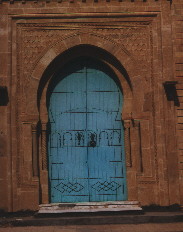 Chapter
10 is already dedicated to visiting Islamic countries as we have noticed
that many overseas visitors tend to exclude them from their program without
really knowing why. A certain amount of blame can be placed at the door
of the TV and newspaper reporters for one-sided reporting - but on the
other hand, they only cater to the viewers or readers and everyday normal
life just doesn't reach the headlines. A South African showed surprise
at my suggestion that Tunisia would be a good place for him to winter over,
but when we talked more about it he related his preconceived notions about
Islamic countries to the reactions he has faced from people who think they
will be shot dead if they spend a holiday in South Africa!
Chapter
10 is already dedicated to visiting Islamic countries as we have noticed
that many overseas visitors tend to exclude them from their program without
really knowing why. A certain amount of blame can be placed at the door
of the TV and newspaper reporters for one-sided reporting - but on the
other hand, they only cater to the viewers or readers and everyday normal
life just doesn't reach the headlines. A South African showed surprise
at my suggestion that Tunisia would be a good place for him to winter over,
but when we talked more about it he related his preconceived notions about
Islamic countries to the reactions he has faced from people who think they
will be shot dead if they spend a holiday in South Africa!
Both Morocco and Tunisia have had very
recent European rule and this has left an impact on both states. French
is widely spoken in Tunisia, and Morocco still has close links with Spain
due both to its proximity and the Spanish community still living in Tangier
- and to the still Spanish town of Ceuta as an enclave in Morocco.
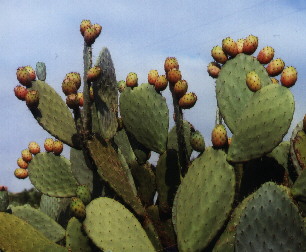 Starting
with Morocco - as this book is taking you from west to east - I must admit
to only having visited very little of the country. I do not want to pass
on second-hand information anywhere in this book without mentioning it
as such, as passed-on information is often much like Chinese whispers -
something quite different comes out at the end of the line. You should
profit from our personal experiences, and they are limited in Morocco to
a visit to Tangier before entering the Mediterranean, accompanied by a
train trip to Asilah.
Starting
with Morocco - as this book is taking you from west to east - I must admit
to only having visited very little of the country. I do not want to pass
on second-hand information anywhere in this book without mentioning it
as such, as passed-on information is often much like Chinese whispers -
something quite different comes out at the end of the line. You should
profit from our personal experiences, and they are limited in Morocco to
a visit to Tangier before entering the Mediterranean, accompanied by a
train trip to Asilah.
We had considered visiting other ports
further south when we left Europe, but as we left from Portugal and not
from the Mediterranean we had to choose between Morocco and Madeira - and
Madeira won!
Nevertheless even a few days in Tangier
are an exciting experience.
Particularly the coastal regions are used
to overseas visitors. Every day ferries come in to Tangier and bring day
trippers and holiday makers. The old town begins right behind the harbor
and as soon as the formalities have been completed (we encountered friendly
and correct officials), you can walk into the narrow streets and are immediately
immersed in the bustling town life.
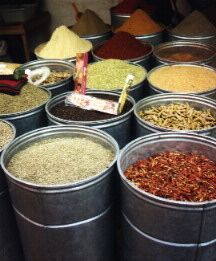 We
accepted the offer of a local "guide" who came to the harbor, when we arrived.
We agreed on a fee and he showed us corners of the old town that we would
not have found otherwise, such as the hand weaving looms tucked away on
the first floor of a market square, where fabric was made on very simple
looms. Had we even found them, we would have felt we were prying into other
people's privacy to go looking through the open doorways. With our guide
however we were able to ask questions and even obtain permission to take
a photo, as he knew the people and knew who would be obliging. That is
the one side of the coin. The other however is that these guides have a
vested interest in bringing your custom to their relative's business, usually
a carpet shop. There you are invited to a cup of tea (as is usual practice
in all Moslem countries, regardless of whether you finally buy or not)
and then carpet upon carpet are laid out before you with expert explanations
in your own language. If you have no intentions of buying, then make it
clear and do not show any interest in the prices - which sooner or later
will be mentioned. Just be a polite and appreciative viewer and leave again
with thanks as soon as you have finished your tea. Maybe your guide will
then take you to another relative selling something else, but perhaps you
really did want to buy jewelry or embossed brass trays or silver teapots
for that excellent mint tea.
We
accepted the offer of a local "guide" who came to the harbor, when we arrived.
We agreed on a fee and he showed us corners of the old town that we would
not have found otherwise, such as the hand weaving looms tucked away on
the first floor of a market square, where fabric was made on very simple
looms. Had we even found them, we would have felt we were prying into other
people's privacy to go looking through the open doorways. With our guide
however we were able to ask questions and even obtain permission to take
a photo, as he knew the people and knew who would be obliging. That is
the one side of the coin. The other however is that these guides have a
vested interest in bringing your custom to their relative's business, usually
a carpet shop. There you are invited to a cup of tea (as is usual practice
in all Moslem countries, regardless of whether you finally buy or not)
and then carpet upon carpet are laid out before you with expert explanations
in your own language. If you have no intentions of buying, then make it
clear and do not show any interest in the prices - which sooner or later
will be mentioned. Just be a polite and appreciative viewer and leave again
with thanks as soon as you have finished your tea. Maybe your guide will
then take you to another relative selling something else, but perhaps you
really did want to buy jewelry or embossed brass trays or silver teapots
for that excellent mint tea.
When you have done enough sightseeing,
take a seat in a street café from where you can watch the passers-by
as they disappear into the depths of the bazaar. The very assortment of
clothing is a fascinating spectacle. There will be European dressed men
and women, in suits and sleeved dresses despite the heat. Women pass in
burnouses, some with only their eyes visible, others more informal using
the burnous as a garment to keep the dust off the dress underneath. There
will be men in lightweight djellabahs embroidered around the sleeve or
across the chest. Men down from the hills for a day in the town will be
wearing woollen djellabahs, mostly brown or gray with white stripes and
with plenty of clothes underneath and even a woollen hat to top it all.
The water vendors with their bright red costumes and brass water ladles
or cups are a sought-after souvenir picture. Mint is delivered to the café
by an old bent man with a handcart who brings an armful of the highly scented
plant for the fresh mint tea.
Public transport in Morocco is confoundingly
cheap. We had considered a trip inland towards Fez (where the tasseled
hats of the same name come from), but the locals in the coastal regions
speak of the towns in the mountains as robbers' dens and we settled for
a train ride along the coast to Asilah. Travelling with public transport
is always an eye-opener in any country, particularly on crowded trains
and buses. In the poorer countries it is not uncommon to share a compartment
with crated chickens - even a goat in very rural areas - as the farmers
take their produce to market. Our experience in Morocco was not quite so
vivid, but nevertheless we accepted the friendly offer of grapes from the
family on the seat opposite and struggled to get out of the train through
the heaps of baggage blocking the doors when we reached our destination.
Asilah turned out to be an attractive walled
town with a vegetable market in the dry moat and a weekly market selling
virtually everything in the streets of the "new town". The narrow alleys
inside the walls were freshly whitewashed and the whole town made a neat
appearance. The harbor was being extended but only sheltered fishing boats
when we were there.
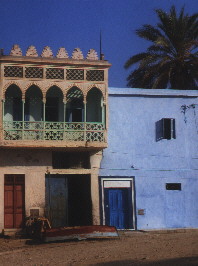 In
Tunisia, the country is more familiar with yacht tourism all along the
coast. There are marinas which serve both yachts in transit and permanent
berth-holders and there are plenty of fishing harbors where yachts can
find a space, usually on the customs pier. The fishing harbors are paid
by the week, the receipt from one harbor being recognized in the next,
although the fee is only small.
In
Tunisia, the country is more familiar with yacht tourism all along the
coast. There are marinas which serve both yachts in transit and permanent
berth-holders and there are plenty of fishing harbors where yachts can
find a space, usually on the customs pier. The fishing harbors are paid
by the week, the receipt from one harbor being recognized in the next,
although the fee is only small.
Tunisia is a country of very contrasting
landscapes. At the eastern end of the vast Sahara desert, there are completely
arid areas in the south with vast salt pans. And yet even in the desert
there is a surprising amount of water and the arid areas are interspersed
with oases growing date palms and other fruit. Further north are extensive
fertile agricultural areas. This was the Granary of the Roman Empire and
still produces grain, wine, olives, fruit and vegetables. In the north
there are green and lush hills where cork oak forests supply their bark
for the cork industry and where the grazing dairy cows and the houses with
tiled sloping roofs are more reminiscent of central Europe than Africa.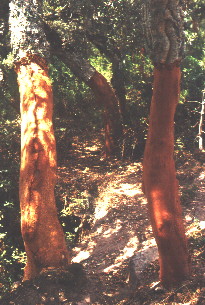
Because of its favorable strategic position
and fertile landscapes, the north of Tunisia was settled early by the Phoenicians.
The Sicily Strait is only about 80 nautical miles wide and so Tunisia has
a commanding location between the eastern and western basins of the Mediterranean.
This made it an ideal situation for the founding of a city that was to
become a name in history - Carthage, a flourishing settlement for centuries.
It was from here that 60 ships with 30.000 settlers set out in 450 BC to
settle the Atlantic coast of Morocco. This particular expedition is on
record, many more have taken place. There are even theories that such a
colonization expedition crossed the Atlantic, maybe unintentionally, and
brought the knowledge of pyramid-building and astronomy along with strains
of cotton plants to the New World. Whatever the truth of this theory, Carthage
was a cultural center and a thorn in the flesh of the Roman Empire, which
finally managed to raze Carthage to the ground in 146 BC. As a result,
the remains of Carthage that can be visited today are only Roman remains,
dating from the settlement later built on the same spot.
However the Punic peoples, as the Phoenicians
were called in the Carthaginian colony, have left other remains and interesting
excavations are going on in Kerkouane which can be visited from Kelibia.
Here the foundations of a town complete with the walls up to about 1 m
height were preserved under sand and are being excavated. The town plan
is easily recognizable, as are the rooms of the houses and even the bath
tubs. The town was enclosed by a town wall with fortress towers. The accompanying
museum exhibits the pottery and jewelry and the coins and seals found in
the excavations and explains the production of purple from the Murex sea
snails, that was carried out there. Purple was so highly prized in ancient
times that it became the color of royalty and it probably made a major
contribution to the prosperity of the town.
The Roman remains left in Tunisia are of
surprising quality. The colosseum El Djem is in far better state than the
one in Rome and is an impressive sight visible for miles around on the
flat plains. Mosaics of great intricacy and color are on display in the
museums of Sousse and Tunis, collections well worth visiting. As with the
Greek remains in Turkey, these sites have not been plundered as quarries
for succeeding generations, nor have they been carried off to foreign museums
during the boom of archeology in the last century to the same extent as
the more densely populated and easily accessible sites in Italy and Greece
themselves.
After the Romans, Tunisia changed hands
many times. It was conquered by the Vandals, then became part of the Byzantine
Empire, then the Arabs came in the 7th century and brought Islam to the
country. After initial bitter resistance, the Berbers were finally conquered
by the Arabs and became ardent advocates of the Islamic religion. It was
a Berber chief who led the troops across the strait of Gibraltar to bring
Islam to Spain in 712. Gibraltar was named after him - Jebel Tariq. After
a brief interlude in which the Spanish devastated Tunis, Tunisia came under
the Ottoman Empire in 1574, when Suleyman the Magnificent was Sultan in
Istanbul. From 1705 onwards it was governed virtually independently under
a Bey, until it became a French Protectorate in 1881. Tunisia became independent
in 1956.
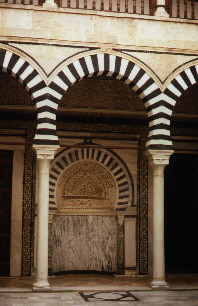 From
671 until the 9th century, Kairouan was the capital of Tunisia. Many magnificent
buildings were erected during this time and even today Kairouan is the
4th holiest city for the Moslems, after Mecca, Medina and Jerusalem. The
great Mosque, the Sidi Abid mausoleum and the so-called Barber's Mosque
are among the highlights of the town. Beautiful ceramics, alabaster and
plasterwork have been used in the creation of these splendid buildings.
As a religious center, many families come with their small boys for the
circumcision festivities. The old town with the bazaar is also worth a
visit. Apart from all the everyday commodities, wool dyed locally is sold
in all colors. Kairouan is best visited on a day trip from Monastir or
Sousse.
From
671 until the 9th century, Kairouan was the capital of Tunisia. Many magnificent
buildings were erected during this time and even today Kairouan is the
4th holiest city for the Moslems, after Mecca, Medina and Jerusalem. The
great Mosque, the Sidi Abid mausoleum and the so-called Barber's Mosque
are among the highlights of the town. Beautiful ceramics, alabaster and
plasterwork have been used in the creation of these splendid buildings.
As a religious center, many families come with their small boys for the
circumcision festivities. The old town with the bazaar is also worth a
visit. Apart from all the everyday commodities, wool dyed locally is sold
in all colors. Kairouan is best visited on a day trip from Monastir or
Sousse.
For those of you who are particularly taken
with the ceramics, visit Nabeul on a Friday. Nabeul is the center of the
ceramic industry in Tunisia and has been so since Roman days. The Arabs
introduced the colorful artistic designs and glazing that are now so popular
and that we saw in southern Spain and will see again in Turkey. Friday
is the weekly market and apart from the wide assortment of tiles and pots,
baskets, leatherwork, embroidery and wrought iron, it is also the cattle
market, where calves, donkeys, sheep, horses, goats and the occasional
dromedary change hands, the deal being sealed with a handshake. As so many
tourists come to Nabeul, there are also displays of horse-riding in the
style of Lawrence of Arabia. Get there early - as Friday is the holy day
for the Moslems the market is closed down by the time of the midday prayer
(not necessarily 12 o'clock, but when the sun is at its peak). If you are
travelling with public transport, it pays to get a bus or collective taxi
(louage) before the market ends, as later it becomes a free-for-all to
try to get in the last bus going back. Nabeul can be visited from the harbors
of Beni Khiar or Kelibia, or maybe in calm weather it might be possible
to anchor in the shallow waters off Hammamet.
Some areas have been particularly developed
for tourism, such as Hammamet, Jerba and the coastline from Monastir to
Sousse. The hotel areas with their own beaches are usually a little apart
from the towns, which, in view of the different cultures is a good idea.
Arriving with a boat in Tunisia means however, that you may wish to use
the beach next to the harbor where the locals go in for a swim in full
dress, or the donkey is given a bath. Respect the local customs and keep
the brief bikini for the hotel swimming pool in Monastir or any other tourist
beach.
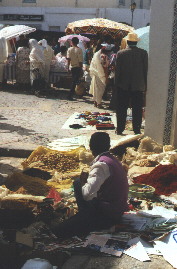 In
medieval tradition the towns are surrounded by a more or less intact town
wall. Medina means the walled part of the town although in Saudi Arabia
and in Malta there are towns where the word has come to be the town name.
The Kasbah is the fortress and the Ribat is also a fortification, built
by Islamic religious-military orders (approximately equivalent to the knights
orders in the times of the crusades). The museums are often located inside
the kasbah. The souks are the market places and the areas around them where
the craftsmen produce and sell their goods. Equipped with this vocabulary,
you can find your way around the towns. Having said this, I must add, that
the souks and the old towns are a labyrinth of tiny alleys where it is
easy to get lost. The back streets are often also very poor and cramped
areas of the town, where a tourist is out of place. Keep to the main streets
to keep your orientation. If you look down on the maze of streets in Sousse
from the kasbah, you may also come to the conclusion that it's easier to
return to the harbor along the outside of the town wall!
In
medieval tradition the towns are surrounded by a more or less intact town
wall. Medina means the walled part of the town although in Saudi Arabia
and in Malta there are towns where the word has come to be the town name.
The Kasbah is the fortress and the Ribat is also a fortification, built
by Islamic religious-military orders (approximately equivalent to the knights
orders in the times of the crusades). The museums are often located inside
the kasbah. The souks are the market places and the areas around them where
the craftsmen produce and sell their goods. Equipped with this vocabulary,
you can find your way around the towns. Having said this, I must add, that
the souks and the old towns are a labyrinth of tiny alleys where it is
easy to get lost. The back streets are often also very poor and cramped
areas of the town, where a tourist is out of place. Keep to the main streets
to keep your orientation. If you look down on the maze of streets in Sousse
from the kasbah, you may also come to the conclusion that it's easier to
return to the harbor along the outside of the town wall!
 Tunis
itself is best visited from La Goulette, although it would be possible
to take the train from Sidi Bou Said. The latter is a marina, and as Sidi
Bou Said has long been an attraction for jet-set tourists, it is more expensive.
The yacht harbor in La Goulette is run by a club and is only a short train
ride from Tunis. A "must" is the museum Bardo for two reasons. Firstly
because the exhibits are excellent (mosaics and local handicrafts) and
secondly because it is in part of the palace of the former Bey, which is
a richly decorated building. The rest of the palace houses the parliament.
Tunis
itself is best visited from La Goulette, although it would be possible
to take the train from Sidi Bou Said. The latter is a marina, and as Sidi
Bou Said has long been an attraction for jet-set tourists, it is more expensive.
The yacht harbor in La Goulette is run by a club and is only a short train
ride from Tunis. A "must" is the museum Bardo for two reasons. Firstly
because the exhibits are excellent (mosaics and local handicrafts) and
secondly because it is in part of the palace of the former Bey, which is
a richly decorated building. The rest of the palace houses the parliament.
When rounding Cape Bon, give Sidi Daoud
a wide berth if you are in the tuna fishing season because of the tuna
fish net which extends out to sea. (See chapter on Fishing).
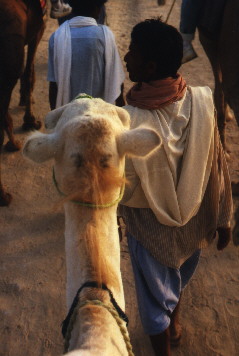 A
particularly good center for trips into the Sahara is Monastir, where the
boat can be left in an excellent marina and where excursions are organized
for tourists. The marina is part of a tourist development with hotels and
pools, and tourist attractions such as folk dancing displays going on the
pier. It is a few minutes walk from the medina, and when you go through
the town gate you are immediately aware of the strong contrast between
the artificial holiday atmosphere of the marina and the everyday town life
with the bustling market. When you have had enough of amenities and other
tourists, and have picked up your mail, head south to Mahdia, where there
is room for a limited number of pleasure craft on the pier directly in
front of the authorities. Immediately beyond are the refrigerated store
rooms and the covered market place for the fish market. The auction in
the early morning is an event, the fish is not always collected in a modern
refrigerated truck, but also by horse-drawn vehicles and donkey carts.
A little bunch of sweet-smelling mimosa, sold by young men in local costume,
is a welcome alternative to the stench of the unwashed ground in the market
during the heat of the day... Mahdia is also an interesting town, but it
would go beyond the scope of this book to go into all the sights of all
the towns.
A
particularly good center for trips into the Sahara is Monastir, where the
boat can be left in an excellent marina and where excursions are organized
for tourists. The marina is part of a tourist development with hotels and
pools, and tourist attractions such as folk dancing displays going on the
pier. It is a few minutes walk from the medina, and when you go through
the town gate you are immediately aware of the strong contrast between
the artificial holiday atmosphere of the marina and the everyday town life
with the bustling market. When you have had enough of amenities and other
tourists, and have picked up your mail, head south to Mahdia, where there
is room for a limited number of pleasure craft on the pier directly in
front of the authorities. Immediately beyond are the refrigerated store
rooms and the covered market place for the fish market. The auction in
the early morning is an event, the fish is not always collected in a modern
refrigerated truck, but also by horse-drawn vehicles and donkey carts.
A little bunch of sweet-smelling mimosa, sold by young men in local costume,
is a welcome alternative to the stench of the unwashed ground in the market
during the heat of the day... Mahdia is also an interesting town, but it
would go beyond the scope of this book to go into all the sights of all
the towns.
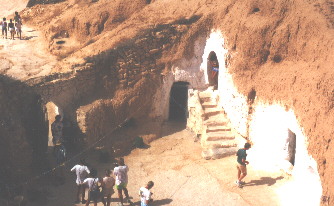 Travelling
in Tunisia provides a lot of variety due to the completely varying landscapes
and the consequent different ways of life between north and south. After
a trip up into the cool forested hills around Ain Draham with the red roofed
houses, it is a particular contrast to visit the dug-out houses of the
Berbers in the area of Matmata and then to bake in the heat crossing the
Chott el Jherid. But even for those who do not venture so far inland, the
country is interesting to visit. Throughout the centuries the main settlement
areas were in the coastal areas, particularly around Cape Bon, so the harbor
towns are full of history and still today throb with life. All around the
Mediterranean, life goes on in the streets, but this is particularly true
of the north African coast.
Travelling
in Tunisia provides a lot of variety due to the completely varying landscapes
and the consequent different ways of life between north and south. After
a trip up into the cool forested hills around Ain Draham with the red roofed
houses, it is a particular contrast to visit the dug-out houses of the
Berbers in the area of Matmata and then to bake in the heat crossing the
Chott el Jherid. But even for those who do not venture so far inland, the
country is interesting to visit. Throughout the centuries the main settlement
areas were in the coastal areas, particularly around Cape Bon, so the harbor
towns are full of history and still today throb with life. All around the
Mediterranean, life goes on in the streets, but this is particularly true
of the north African coast.
© Dianne Reichart
1997
List of contents
 Chapter
10 is already dedicated to visiting Islamic countries as we have noticed
that many overseas visitors tend to exclude them from their program without
really knowing why. A certain amount of blame can be placed at the door
of the TV and newspaper reporters for one-sided reporting - but on the
other hand, they only cater to the viewers or readers and everyday normal
life just doesn't reach the headlines. A South African showed surprise
at my suggestion that Tunisia would be a good place for him to winter over,
but when we talked more about it he related his preconceived notions about
Islamic countries to the reactions he has faced from people who think they
will be shot dead if they spend a holiday in South Africa!
Chapter
10 is already dedicated to visiting Islamic countries as we have noticed
that many overseas visitors tend to exclude them from their program without
really knowing why. A certain amount of blame can be placed at the door
of the TV and newspaper reporters for one-sided reporting - but on the
other hand, they only cater to the viewers or readers and everyday normal
life just doesn't reach the headlines. A South African showed surprise
at my suggestion that Tunisia would be a good place for him to winter over,
but when we talked more about it he related his preconceived notions about
Islamic countries to the reactions he has faced from people who think they
will be shot dead if they spend a holiday in South Africa!
 Starting
with Morocco - as this book is taking you from west to east - I must admit
to only having visited very little of the country. I do not want to pass
on second-hand information anywhere in this book without mentioning it
as such, as passed-on information is often much like Chinese whispers -
something quite different comes out at the end of the line. You should
profit from our personal experiences, and they are limited in Morocco to
a visit to Tangier before entering the Mediterranean, accompanied by a
train trip to Asilah.
Starting
with Morocco - as this book is taking you from west to east - I must admit
to only having visited very little of the country. I do not want to pass
on second-hand information anywhere in this book without mentioning it
as such, as passed-on information is often much like Chinese whispers -
something quite different comes out at the end of the line. You should
profit from our personal experiences, and they are limited in Morocco to
a visit to Tangier before entering the Mediterranean, accompanied by a
train trip to Asilah.
 We
accepted the offer of a local "guide" who came to the harbor, when we arrived.
We agreed on a fee and he showed us corners of the old town that we would
not have found otherwise, such as the hand weaving looms tucked away on
the first floor of a market square, where fabric was made on very simple
looms. Had we even found them, we would have felt we were prying into other
people's privacy to go looking through the open doorways. With our guide
however we were able to ask questions and even obtain permission to take
a photo, as he knew the people and knew who would be obliging. That is
the one side of the coin. The other however is that these guides have a
vested interest in bringing your custom to their relative's business, usually
a carpet shop. There you are invited to a cup of tea (as is usual practice
in all Moslem countries, regardless of whether you finally buy or not)
and then carpet upon carpet are laid out before you with expert explanations
in your own language. If you have no intentions of buying, then make it
clear and do not show any interest in the prices - which sooner or later
will be mentioned. Just be a polite and appreciative viewer and leave again
with thanks as soon as you have finished your tea. Maybe your guide will
then take you to another relative selling something else, but perhaps you
really did want to buy jewelry or embossed brass trays or silver teapots
for that excellent mint tea.
We
accepted the offer of a local "guide" who came to the harbor, when we arrived.
We agreed on a fee and he showed us corners of the old town that we would
not have found otherwise, such as the hand weaving looms tucked away on
the first floor of a market square, where fabric was made on very simple
looms. Had we even found them, we would have felt we were prying into other
people's privacy to go looking through the open doorways. With our guide
however we were able to ask questions and even obtain permission to take
a photo, as he knew the people and knew who would be obliging. That is
the one side of the coin. The other however is that these guides have a
vested interest in bringing your custom to their relative's business, usually
a carpet shop. There you are invited to a cup of tea (as is usual practice
in all Moslem countries, regardless of whether you finally buy or not)
and then carpet upon carpet are laid out before you with expert explanations
in your own language. If you have no intentions of buying, then make it
clear and do not show any interest in the prices - which sooner or later
will be mentioned. Just be a polite and appreciative viewer and leave again
with thanks as soon as you have finished your tea. Maybe your guide will
then take you to another relative selling something else, but perhaps you
really did want to buy jewelry or embossed brass trays or silver teapots
for that excellent mint tea.
 In
Tunisia, the country is more familiar with yacht tourism all along the
coast. There are marinas which serve both yachts in transit and permanent
berth-holders and there are plenty of fishing harbors where yachts can
find a space, usually on the customs pier. The fishing harbors are paid
by the week, the receipt from one harbor being recognized in the next,
although the fee is only small.
In
Tunisia, the country is more familiar with yacht tourism all along the
coast. There are marinas which serve both yachts in transit and permanent
berth-holders and there are plenty of fishing harbors where yachts can
find a space, usually on the customs pier. The fishing harbors are paid
by the week, the receipt from one harbor being recognized in the next,
although the fee is only small.

 From
671 until the 9th century, Kairouan was the capital of Tunisia. Many magnificent
buildings were erected during this time and even today Kairouan is the
4th holiest city for the Moslems, after Mecca, Medina and Jerusalem. The
great Mosque, the Sidi Abid mausoleum and the so-called Barber's Mosque
are among the highlights of the town. Beautiful ceramics, alabaster and
plasterwork have been used in the creation of these splendid buildings.
As a religious center, many families come with their small boys for the
circumcision festivities. The old town with the bazaar is also worth a
visit. Apart from all the everyday commodities, wool dyed locally is sold
in all colors. Kairouan is best visited on a day trip from Monastir or
Sousse.
From
671 until the 9th century, Kairouan was the capital of Tunisia. Many magnificent
buildings were erected during this time and even today Kairouan is the
4th holiest city for the Moslems, after Mecca, Medina and Jerusalem. The
great Mosque, the Sidi Abid mausoleum and the so-called Barber's Mosque
are among the highlights of the town. Beautiful ceramics, alabaster and
plasterwork have been used in the creation of these splendid buildings.
As a religious center, many families come with their small boys for the
circumcision festivities. The old town with the bazaar is also worth a
visit. Apart from all the everyday commodities, wool dyed locally is sold
in all colors. Kairouan is best visited on a day trip from Monastir or
Sousse.
 In
medieval tradition the towns are surrounded by a more or less intact town
wall. Medina means the walled part of the town although in Saudi Arabia
and in Malta there are towns where the word has come to be the town name.
The Kasbah is the fortress and the Ribat is also a fortification, built
by Islamic religious-military orders (approximately equivalent to the knights
orders in the times of the crusades). The museums are often located inside
the kasbah. The souks are the market places and the areas around them where
the craftsmen produce and sell their goods. Equipped with this vocabulary,
you can find your way around the towns. Having said this, I must add, that
the souks and the old towns are a labyrinth of tiny alleys where it is
easy to get lost. The back streets are often also very poor and cramped
areas of the town, where a tourist is out of place. Keep to the main streets
to keep your orientation. If you look down on the maze of streets in Sousse
from the kasbah, you may also come to the conclusion that it's easier to
return to the harbor along the outside of the town wall!
In
medieval tradition the towns are surrounded by a more or less intact town
wall. Medina means the walled part of the town although in Saudi Arabia
and in Malta there are towns where the word has come to be the town name.
The Kasbah is the fortress and the Ribat is also a fortification, built
by Islamic religious-military orders (approximately equivalent to the knights
orders in the times of the crusades). The museums are often located inside
the kasbah. The souks are the market places and the areas around them where
the craftsmen produce and sell their goods. Equipped with this vocabulary,
you can find your way around the towns. Having said this, I must add, that
the souks and the old towns are a labyrinth of tiny alleys where it is
easy to get lost. The back streets are often also very poor and cramped
areas of the town, where a tourist is out of place. Keep to the main streets
to keep your orientation. If you look down on the maze of streets in Sousse
from the kasbah, you may also come to the conclusion that it's easier to
return to the harbor along the outside of the town wall!
 Tunis
itself is best visited from La Goulette, although it would be possible
to take the train from Sidi Bou Said. The latter is a marina, and as Sidi
Bou Said has long been an attraction for jet-set tourists, it is more expensive.
The yacht harbor in La Goulette is run by a club and is only a short train
ride from Tunis. A "must" is the museum Bardo for two reasons. Firstly
because the exhibits are excellent (mosaics and local handicrafts) and
secondly because it is in part of the palace of the former Bey, which is
a richly decorated building. The rest of the palace houses the parliament.
Tunis
itself is best visited from La Goulette, although it would be possible
to take the train from Sidi Bou Said. The latter is a marina, and as Sidi
Bou Said has long been an attraction for jet-set tourists, it is more expensive.
The yacht harbor in La Goulette is run by a club and is only a short train
ride from Tunis. A "must" is the museum Bardo for two reasons. Firstly
because the exhibits are excellent (mosaics and local handicrafts) and
secondly because it is in part of the palace of the former Bey, which is
a richly decorated building. The rest of the palace houses the parliament.
 A
particularly good center for trips into the Sahara is Monastir, where the
boat can be left in an excellent marina and where excursions are organized
for tourists. The marina is part of a tourist development with hotels and
pools, and tourist attractions such as folk dancing displays going on the
pier. It is a few minutes walk from the medina, and when you go through
the town gate you are immediately aware of the strong contrast between
the artificial holiday atmosphere of the marina and the everyday town life
with the bustling market. When you have had enough of amenities and other
tourists, and have picked up your mail, head south to Mahdia, where there
is room for a limited number of pleasure craft on the pier directly in
front of the authorities. Immediately beyond are the refrigerated store
rooms and the covered market place for the fish market. The auction in
the early morning is an event, the fish is not always collected in a modern
refrigerated truck, but also by horse-drawn vehicles and donkey carts.
A little bunch of sweet-smelling mimosa, sold by young men in local costume,
is a welcome alternative to the stench of the unwashed ground in the market
during the heat of the day... Mahdia is also an interesting town, but it
would go beyond the scope of this book to go into all the sights of all
the towns.
A
particularly good center for trips into the Sahara is Monastir, where the
boat can be left in an excellent marina and where excursions are organized
for tourists. The marina is part of a tourist development with hotels and
pools, and tourist attractions such as folk dancing displays going on the
pier. It is a few minutes walk from the medina, and when you go through
the town gate you are immediately aware of the strong contrast between
the artificial holiday atmosphere of the marina and the everyday town life
with the bustling market. When you have had enough of amenities and other
tourists, and have picked up your mail, head south to Mahdia, where there
is room for a limited number of pleasure craft on the pier directly in
front of the authorities. Immediately beyond are the refrigerated store
rooms and the covered market place for the fish market. The auction in
the early morning is an event, the fish is not always collected in a modern
refrigerated truck, but also by horse-drawn vehicles and donkey carts.
A little bunch of sweet-smelling mimosa, sold by young men in local costume,
is a welcome alternative to the stench of the unwashed ground in the market
during the heat of the day... Mahdia is also an interesting town, but it
would go beyond the scope of this book to go into all the sights of all
the towns.
 Travelling
in Tunisia provides a lot of variety due to the completely varying landscapes
and the consequent different ways of life between north and south. After
a trip up into the cool forested hills around Ain Draham with the red roofed
houses, it is a particular contrast to visit the dug-out houses of the
Berbers in the area of Matmata and then to bake in the heat crossing the
Chott el Jherid. But even for those who do not venture so far inland, the
country is interesting to visit. Throughout the centuries the main settlement
areas were in the coastal areas, particularly around Cape Bon, so the harbor
towns are full of history and still today throb with life. All around the
Mediterranean, life goes on in the streets, but this is particularly true
of the north African coast.
Travelling
in Tunisia provides a lot of variety due to the completely varying landscapes
and the consequent different ways of life between north and south. After
a trip up into the cool forested hills around Ain Draham with the red roofed
houses, it is a particular contrast to visit the dug-out houses of the
Berbers in the area of Matmata and then to bake in the heat crossing the
Chott el Jherid. But even for those who do not venture so far inland, the
country is interesting to visit. Throughout the centuries the main settlement
areas were in the coastal areas, particularly around Cape Bon, so the harbor
towns are full of history and still today throb with life. All around the
Mediterranean, life goes on in the streets, but this is particularly true
of the north African coast.